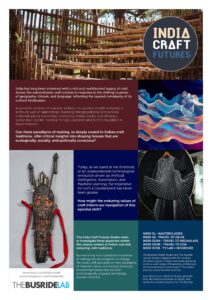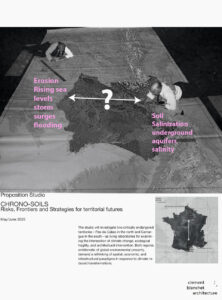Course descriptions, learning objectives, travel dates, and more
Ayaz Basrai | India-based co-founder of The Busride Design Studio and CEPT University faculty
India Craft Futures
Location(s): India – Delhi, Meghalaya, Goa
Dates of Travel: Spring Half-Term

India has long been entwined with a rich and multifaceted legacy of craft. Across the subcontinent, craft evolves in response to the shifting nuances of geography, climate, and language, reflecting the layered complexity of its cultural landscapes. Beyond the creation of exquisite artefacts, the practice of craft embodies a profound web of relationships: fostering intergenerational connections, mbedding local knowledge, reinforcing familial bonds, and offering a sustainable counter-narrative to high-capitalism and techno-feudalism in equal measure. Craft’s relevance extends beyond heritage—it is a lens through which we might envision and articulate futures that are meaningful, equitable, and resilient.
Throughout history, craft has emerged as a counterpoint during moments of profound societal transformation. Each Industrial Revolution has been shadowed by a corresponding craft movement—an embodied response to the mechanisation of labor and the abstraction of human connection. Movements such as Art Nouveau, the Arts and Crafts movement, and the American Craftsman tradition resisted the dehumanising forces of industrialisation, privileging materiality, mastery, and locality in the face of upheaval.
Today, as we stand at the threshold of an unprecedented technological revolution driven by Artificial Intelligence, Automation, and Machine Learning, the imperative for such a counterpoint has never been greater. How might the enduring values of craft inform our navigation of this epochal shift? Can the paradigms of making—deeply rooted in Indian craft traditions—offer critical insights into shaping futures that are ecologically, socially, and politically conscious?
The India Craft Futures Studio seeks to investigate these questions within the unique context of India’s vast and enduring craft traditions.
Clement Blanchet | Paris-based principal of Clement Blanchet Architecture
CHRONO-SOILS: Risks, Frontiers, and Strategies for Territorial Futures
Location(s): France – Paris, Camargue, Pas de Calais
Dates of Travel: Spring Half-Term
Student Cost Estimate *** Note: All budget figures are estimates***
This advanced design studio is part of the Beyond 2025 building festival, engaging critically with the theme of resources through a multi-scalar and cross-disciplinary lens. The studio launches in early May with an international kickoff event in collaboration with the Arpenter Chair and Puca, setting the stage for transatlantic dialogue. With the potential involvement of Vinci doctoral students and professional mentors, the studio will foster a dynamic exchange between Michigan students and European practitioners.
Over an intensive two-month period, the studio will engage in a structured dialogue with two leading French architectural institutions: Ecole Nationale Superieure d’Architecture de Paris-La Villette and Ecole Nationale Superieure d’Architecture de Marseille. Building upon research initiated in the architectural studios concluding in February 2024, this collaboration provides an opportunity to investigate architecture’s role in responding to ecological and socio-political uncertainties. Under the guidance of Professor Eric Daniel-Lacombe (curator of the French Pavilion at the 2025 Venice Biennale) and Professor Matthieu Duperrex, the discourse will center on natural risks, territorial resilience, and architecture’s agency in shaping adaptive strategies.
As a direct extension of the 2025 Venice Architecture Biennale’s curatorial framework, selected student work may be exhibited in September 2025 as part of Venice and its Resonances, positioning emerging architectural inquiries within an international platform.
The studio synthesizes exploration, design speculation, and strategic interventions addressing risk, resilience, and the entanglements of geography and economy. Through critical research and site-based analysis, students will develop design methodologies that interrogate architecture’s capacity to mediate complex environmental and infrastructural conditions.
